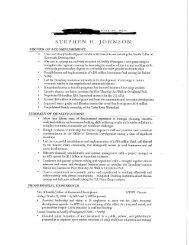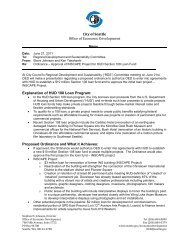2013 Water System Plan, Volume II - Seattle City Clerk's Office - City ...
2013 Water System Plan, Volume II - Seattle City Clerk's Office - City ...
2013 Water System Plan, Volume II - Seattle City Clerk's Office - City ...
Create successful ePaper yourself
Turn your PDF publications into a flip-book with our unique Google optimized e-Paper software.
Chapter 5 <strong>Water</strong> Infrastructure<br />
Table 5-9 lists ductile iron pipe coating options. SPU requires a double cement mortar<br />
lining thickness for ductile iron pipe. See AWWA C104 for more detail on cement mortar<br />
linings for ductile iron pipe.<br />
Table 5-9 Ductile Iron Pipe Coating Types for SPU <strong>Water</strong> <strong>System</strong><br />
Coating<br />
Thermoplastic<br />
Powder Coating<br />
Wax Tape system<br />
Polyethylene film<br />
encasement (unbonded<br />
film)<br />
Fusion-Bonded<br />
Epoxy, Polyurethane,<br />
and Tape Coatings<br />
SPU Preference<br />
SPU standard coating for ductile iron (DI) pipe in a corrosive environment. See<br />
Standard Spec 9-30.1(6)C. Can also be used on steel pipe.<br />
When used with appropriate primer and a fiber reinforced outer wrap, this<br />
coating can protect any buried metal surface, bolts, nuts, rods, copper, ductile,<br />
steel, etc.<br />
Common application for corrosion control. Acts as an environmental barrier to<br />
prevent direct contact between pipe and corrosive soils. Not watertight;<br />
groundwater can seep beneath the wrap. Integrity depends on proper installation,<br />
careful handling by contractor, and inspection by owner. Polyethylene encasement<br />
must be per Standard Spec 9-30.1(6) D. SPU has limited success using this<br />
product.<br />
Can be considered as an alternative coating system. Manufacturer has been<br />
unwilling to apply bonded coating at factory. Design engineer should recognize<br />
potential invalidation of pipe warranty if this is field applied.<br />
C. Linings<br />
Lining refers to a product used to protect the inside of a pipe from corrosion and<br />
improve performance and service life. SPU requires a lining for all pipelines. All linings<br />
must be National Sanitation Foundation (NSF) 61-approved.<br />
Ductile iron pipe is typically supplied with a double thickness Portland cement-mortar<br />
lining unless otherwise specified. See Standard Specification 9-30.1(1).<br />
Welded steel pipe is furnished with two primary lining options: cement-mortar or<br />
polyurethane. Cement mortar is a nominal thickness of ¼- to ½-inch. For interior linings,<br />
polyurethane thickness is typically around 20-mils. See Standard Specification 9-30.1(1).<br />
D. Cathodic Protection<br />
Cathodic protection is a means of providing a sacrificial material to become the point<br />
where corrosion occurs.<br />
For a pipeline, cathodic protection provides a separate metal known as a sacrificial<br />
anode to be the point where corrosion occurs. This anode protects the pipeline from<br />
corrosion. By use of either an impressed current rectifier or materials that are<br />
galvanically active (zinc or magnesium), the pipeline becomes the cathode and corrosion<br />
is transferred to the anode.<br />
See DSG Chapter 6, Cathodic Protection, for standards for cathodic protection systems.<br />
E. Environmental Modifications<br />
SPU employs corrosion control techniques such as modifying the pH at its water<br />
treatment plants to reduce internal corrosion of water pipelines. This practice is<br />
controlled by federal regulation under the Safe Drinking <strong>Water</strong> Act and EPA’s Lead and<br />
Copper Rule and is a water quality operational methodology beyond the scope of this<br />
DSG.<br />
SPU Design Standards and Guidelines<br />
5-39
















